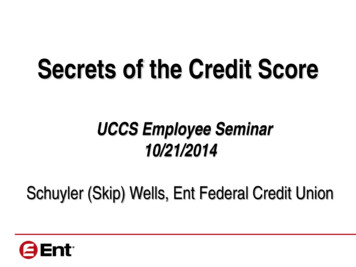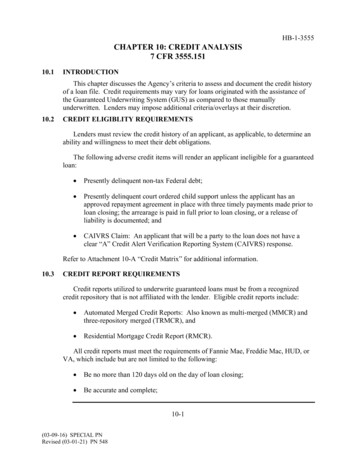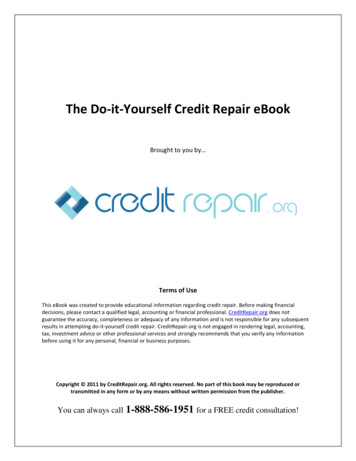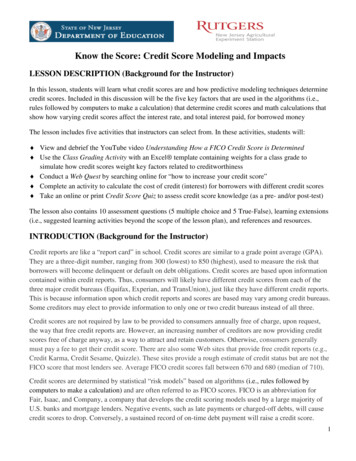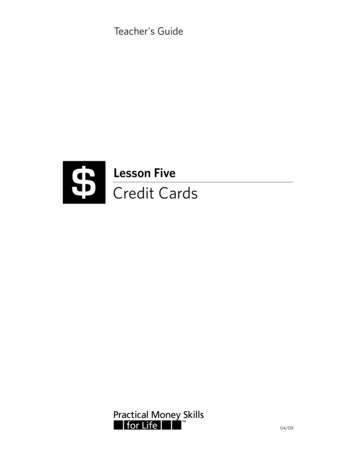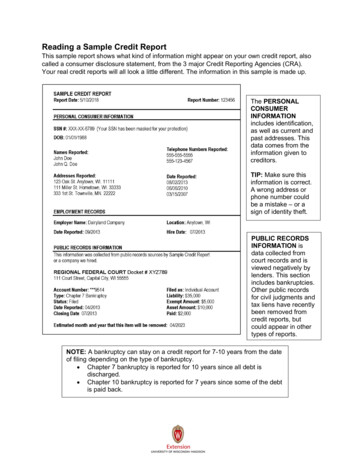
Transcription
Reading a Sample Credit ReportThis sample report shows what kind of information might appear on your own credit report, alsocalled a consumer disclosure statement, from the 3 major Credit Reporting Agencies (CRA).Your real credit reports will all look a little different. The information in this sample is made up.The PERSONALCONSUMERINFORMATIONincludes identification,as well as current andpast addresses. Thisdata comes from theinformation given tocreditors.TIP: Make sure thisinformation is correct.A wrong address orphone number couldbe a mistake – or asign of identity theft.PUBLIC RECORDSINFORMATION isdata collected fromcourt records and isviewed negatively bylenders. This sectionincludes bankruptcies.Other public recordsfor civil judgments andtax liens have recentlybeen removed fromcredit reports, butcould appear in othertypes of reports.NOTE: A bankruptcy can stay on a credit report for 7-10 years from the dateof filing depending on the type of bankruptcy. Chapter 7 bankruptcy is reported for 10 years since all debt isdischarged. Chapter 10 bankruptcy is reported for 7 years since some of the debtis paid back.
ADVERSEACCOUNTS show linesof credit that have notbeen paid, have missedor late payments, weresent to a collectionagency, or were“charged off” meaningthat the companyreported the debt aslost income and mayhave sold the debt to acollection agency. Ahistory of late paymentslowers your creditscore, especially if it’smore recent. Manylenders will not offercredit until overduedebts have been paid.TIP: Negative itemscan legally be removedfrom a credit report ifit’s been more than 7years from the date thedebt first becameoverdue. If old itemsare listed, contact thecredit bureau and askthese accounts to betaken off.NOTE: Even if debtdoes not show up on acredit report after 7years, a person maystill owe the debt andbe taken to court,depending on the Stateand type of debt.NOTE: Even if debt does not appear on a credit report, the ConsumerReporting Agencies (CRA’s) keep your older debt on file and can release theinformation when you apply for the following: Credit of 150,000 or more, such as a mortgage.Life insurance with a face value of 150,000 or more.A job with an annual salary of 75,000 or more.
The SATISFACTORYACCOUNTS sectionshows creditaccounts that arecurrent or have beenpaid as agreed. Theaccounts listed arefrom informationreported by lenders.Creditors choosewhether to reportaccount informationto none, one, two, orall three of the majorCredit ReportingAgencies and howoften to report.Having satisfactoryaccounts that you paythe balance onregularly is good foryour credit score.The ‘Account Type’lists the kind of creditaccount. InstallmentAccounts – like caror student loanswhere you borrow aset amount andthen make monthlypayments. Revolving Accounts– usually creditcards that have acredit limit.TIP: The ‘Credit Utilization Ratio” (CUR) is how much of the balance is currentlyreported as being used in all your revolving accounts combined.In this sample report, there’s only one revolving account. The credit card accountabove has a 387 balance divided by 1000 limit 38% CUR.To raise your credit score, keep your CUR under 25%. Some credit scoringmodels say to keep this ratio under 5% for a better credit score.
In theSATISFACTORYACCOUNTS section,future creditors,insurance companies,landlords, and someemployers look for ahistory of on-timepayments as a signthat a person isresponsible andtrustworthy. Positiveinformation is usuallylisted for 10 years afteran account is closed orpaid off. If there is ahistory of latepayments, creditorsand insurers may stillwork with a person, butwill charge higherrates.TIP: Make sureaccounts listed belongto you and that theinformation is correct.When you order yourreport, Credit ReportingAgencies (CRA’s) arerequired to provideinformation about howto dispute an item orcorrect an error in yourreport. Keep a copy ofany letters or emailsyou send and customerservice representativesyou speak with. TheCRA usually has 30days to fix the error orshow why it’s correct.TIP: Applying for credit could lower your credit score a few points each timeyou contact a lender. If you’re shopping for the best interest rate on a carloan, get a few quotes for loans within 14 days of each other. When shoppingfor a mortgage, get quotes within 30 days of each other. Most credit scoreswill only count these inquiries as one item, instead of many requests.
The CREDITINQUIRIES sectionincludes informationabout when a creditreport has beenrequested. There aretwo types of inquiries:REGULAR INQUIRIESare also known asHARD inquiries. Whenyou apply for credit orbuy insurance, forexample, the lenderreviews your creditreport for a positivehistory and creditworthiness. Theseinquiries stay on areport for 2 years andcan be seen by allcreditors who look upyour report. Hardinquiries can drop acredit score by 5-20points for many months.ACCOUNT REVIEWinquiries are also calledSOFT or Promotionalinquiries. Companiesask for certain parts ofyour credit informationto see if you qualify fortheir services. Theseitems are only seen byyou and do not affectyour credit score.NOTE: You have the right to add a short statement to your credit report todispute a credit item or explain a situation. The statement does not affect yourcredit score and many lenders may never even read it.Office contact informationAuthored by Peggy Olive, Financial Capability Specialist, University of Wisconsin. Copyright 2018 by the Board of Regents of the University ofWisconsin System doing business as the division of Cooperative Extension of the University of Wisconsin-Extension. All rights reserved.
credit reports, but could appear in other types of reports. NOTE: A bankruptcy can stay on a credit report for 7-10 years from the date of filing depending on the type of bankruptcy. Chapter 7 bankruptcy is reported for 10 years since all debt is discharged. Chapter 10 bankruptcy is



